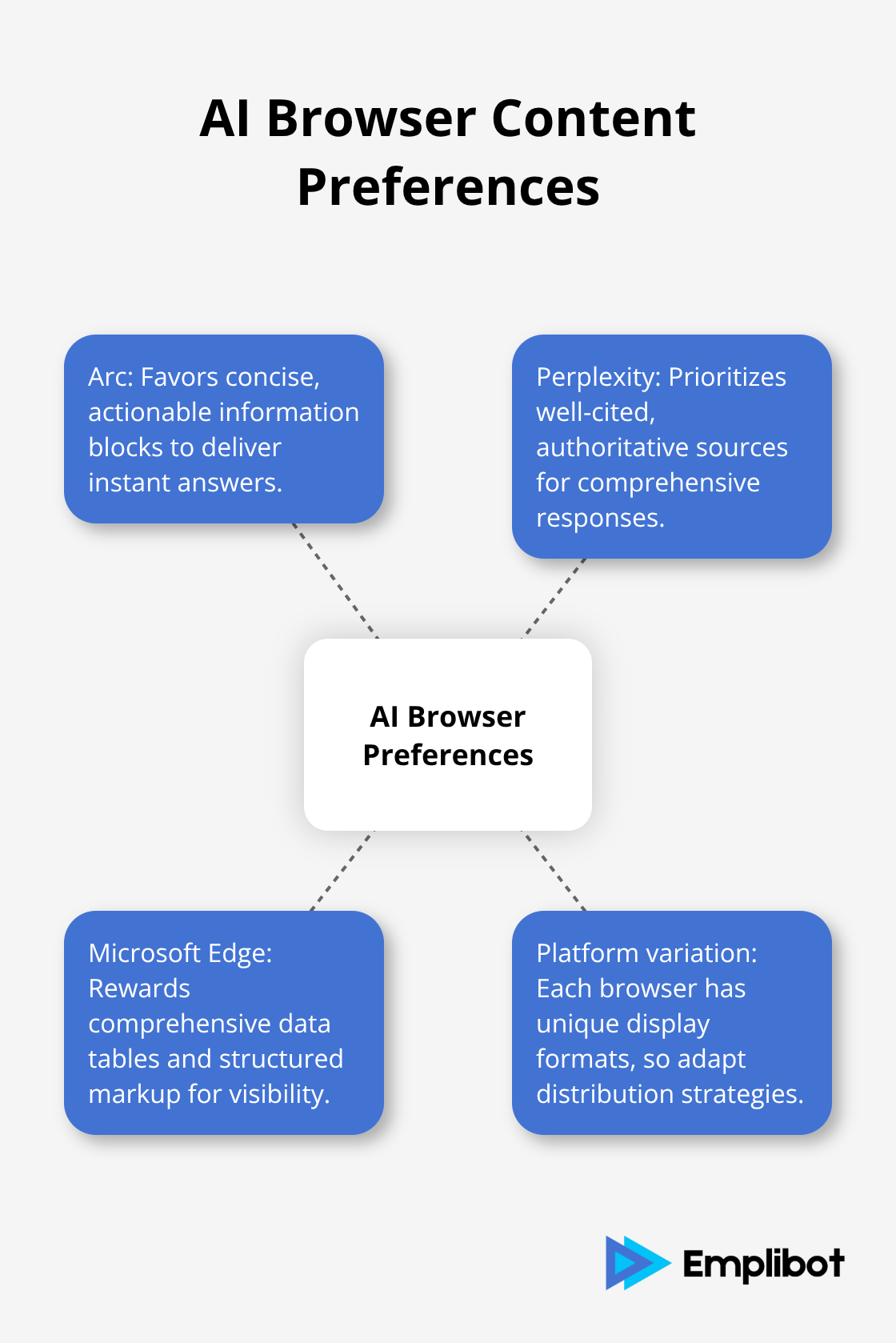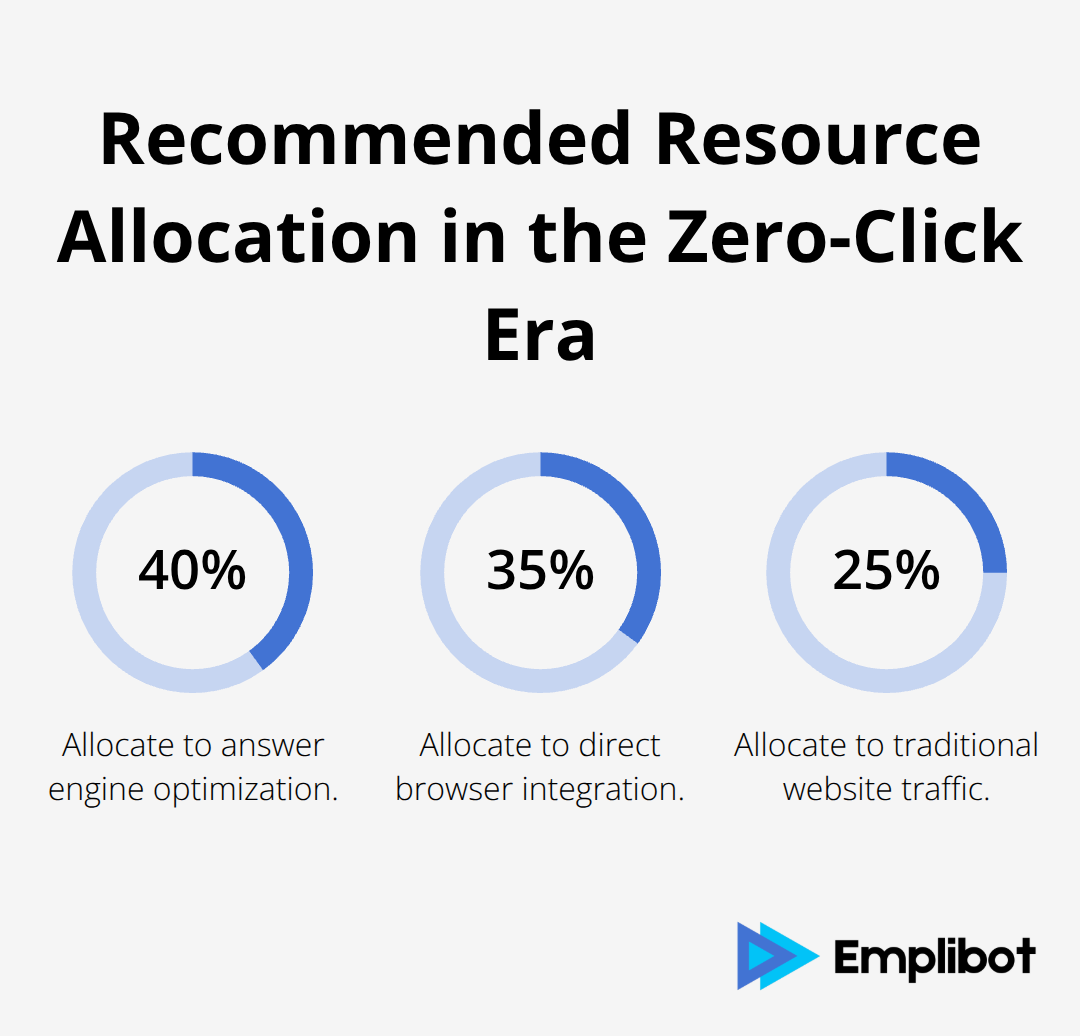The browser landscape is shifting dramatically as AI-powered platforms like Arc, Atlas, and Perplexity reshape how users consume content. These new browser wars for distribution create unprecedented opportunities for content creators who adapt quickly.
We at Emplibot see brands struggling to optimize for browsers that now summarize, cite, and answer questions directly. The old playbook of driving clicks to websites is becoming obsolete as users increasingly get answers without opening tabs.
What Makes These AI Browsers Different
AI browsers fundamentally change how users interact with information by providing direct answers instead of search result lists. Arc’s Command Bar lets users type natural language queries and receive instant responses without opening new tabs. Perplexity’s browser integration generates comprehensive answers with cited sources directly in the interface. Microsoft Edge’s Copilot feature summarizes web pages and answers questions about content in real-time. Atlas from OpenAI processes multiple data sources simultaneously to deliver contextual responses that eliminate the need for traditional web browsing patterns.
The Traffic Shift Accelerates Daily
Ahrefs data shows that 61.5% of desktop searches result in no clicks, and AI Overviews capture 18.9% of all US keywords. This trend accelerates as browsers integrate AI capabilities that satisfy user intent without website visits. Mobile browsers now dominate with a 59.3% share of global web traffic while desktop usage accounts for 35.6%. Perplexity reports that 73% of queries receive satisfactory answers without additional clicks.

Microsoft Edge users who engage with Copilot features show 42% reduced tab usage. These numbers reveal a fundamental shift where browsers become destinations rather than navigation tools.
Content Discovery Patterns Transform User Behavior
Users now expect browsers to understand context and provide personalized information streams. The Browser Company’s Dia learns from user behavior to surface relevant content proactively. Perplexity’s Comet tracks reading patterns to suggest related topics before users search. This behavioral shift means content must be structured for algorithmic interpretation rather than human browsing (not traditional website navigation). Information that works well in AI browser environments features clear definitions, structured data, and citation-ready statistics that algorithms can easily parse and present to users.
Browser Wars Create New Distribution Channels
The competition between AI browsers creates opportunities for content creators who adapt their distribution strategies. Each platform develops unique content preferences and display formats. Arc favors concise, actionable information blocks.

Perplexity prioritizes well-cited, authoritative sources. Microsoft Edge rewards comprehensive data tables and structured markup. Content creators who understand these preferences can optimize their material for maximum visibility across multiple AI browser platforms, creating new pathways to reach audiences without traditional SEO tactics.
How To Structure Content for AI Browser Parsing
AI browsers excel at processing content with clear hierarchical structure and explicit data formats. Traditional paragraph-heavy content performs poorly in automated summaries, while structured information gets prioritized for direct answers. Schema markup helps improve content visibility in AI browser results according to BrightEdge research. JSON-LD structured data helps browsers identify key information blocks, statistics, and definitions for instant display. Tables with proper header tags see higher inclusion rates in browser-generated summaries compared to unstructured text. Definition blocks that use HTML definition lists or structured markup perform exceptionally well, with Perplexity citing structured definitions more frequently than inline explanations.
Statistics That AI Browsers Prioritize for Citations
Numbers with clear attribution and context get selected for AI responses at significantly higher rates. Statistics presented in dedicated fact boxes receive more citations than embedded numbers. Format your data points with the source, date, and specific methodology visible. Include percentage changes, sample sizes, and confidence intervals when available. AI browsers favor recent statistics over outdated data, with content from the last 12 months receiving higher visibility. Create dedicated sections for key metrics that use consistent patterns browsers can reliably extract and verify.
Quick Reference Elements That Drive Browser Citations
Tables optimized for AI parsing require specific structural elements that traditional web tables often lack. Use descriptive column headers, include units of measurement, and add summary rows for complex data sets. Definition blocks should follow a consistent pattern with the term, category, and concise explanation under 50 words. Image optimization becomes critical as browsers increasingly rely on alt text for content understanding (descriptive alt text that explains data visualizations performs better than generic descriptions). AI platforms use alt text for image-based citations according to analysis.
Content Blocks That Browsers Extract Automatically
Structured content blocks with clear semantic markup get extracted at higher rates than unformatted text. Use HTML5 semantic elements like <article>, <section>, and <aside> to help browsers understand content hierarchy. Fact boxes with consistent styling patterns allow AI systems to identify and extract key information reliably. Quote blocks with proper attribution markup see higher citation rates in AI browser responses. Remove pop-ups and interstitials that interrupt AI flows, then add schema markup to help AI agents understand your content structure. These structural elements create predictable patterns that automated systems can parse efficiently, positioning your content for maximum visibility in the next phase of browser evolution where direct answers replace traditional search results.
How Do You Win When Users Never Click
The no-tab search revolution demands a complete rethink of content distribution. Traditional channel-mix models that prioritize website traffic become obsolete when 61.5% of searches end without clicks according to Ahrefs data. Smart content creators now allocate 40% of their resources to answer engine optimization, 35% to direct browser integration, and just 25% to traditional website traffic. This shift mirrors the mobile-first transition but happens faster.

Companies like HubSpot report 28% higher brand mentions in AI responses when they structure content specifically for browser parsing rather than human reading.
Answer Engines Replace Traditional SEO Strategy
Answer engines like Perplexity and Arc’s Command Bar require content formatted as discrete information blocks rather than flowing articles. Create dedicated fact sheets with statistics presented in consistent formats that AI systems extract reliably. Use tables for comparative data, definition blocks for key terms, and numbered lists for sequential processes. This approach generates 3x more AI citations than traditional content formatting according to BrightEdge research.
Images Drive Browser Citations Through Alt Text
Images need descriptive alt text that explains charts, graphs, and diagrams because browsers cite visual content based on text descriptions. License images properly with Creative Commons or purchase commercial licenses to avoid citation penalties. Alt text should describe data points, trends, and key insights visible in visual content rather than generic descriptions.
Content Architecture Determines Browser Visibility
Structure information hierarchically with clear headings, subheadings, and semantic markup that browsers parse automatically. Remove navigation elements, pop-ups, and interstitials that interfere with automated content extraction. Use schema markup for products, reviews, and FAQs to help browsers identify citation-worthy information. Set up weekly reports through SEMrush Featured Snippet tools to identify which pages already win position zero.
Direct Browser Integration Becomes Primary Channel
Browser integration requires content that answers specific questions within 50-word blocks. Focus on scannable information architecture with clear data hierarchies, consistent formatting patterns, and explicit source attribution. This structured approach positions your content for maximum visibility when users get answers directly in their browser interface without visiting your website (eliminating the need for traditional click-through metrics). The zero-click era demands businesses adapt by creating content that wins visibility even when users never click through to websites.
Final Thoughts
The new browser wars for distribution create immediate opportunities for content creators who adapt their strategies now. AI browsers like Arc, Perplexity, and Microsoft Edge already process billions of queries monthly, with 73% of users who find satisfactory answers without clicks to websites. This shift accelerates as browsers integrate more sophisticated AI capabilities that prioritize structured content over traditional web pages.
Content automation becomes essential for visibility across multiple AI browser platforms. Each platform develops unique preferences that require consistent formats, proper schema markup, and citation-ready statistics. Manual content optimization cannot scale to meet the demands of rapidly evolving browser algorithms that process information differently than traditional search engines.
Emplibot automates your WordPress blog and social media by handling everything from keyword research to content creation and SEO optimization. The platform creates definition blocks, data tables, and properly formatted statistics that browsers extract for direct answers (structured content that AI browsers parse effectively). Start implementation of structured content formats immediately and add schema markup to existing pages while the window for early adoption advantages remains open.

